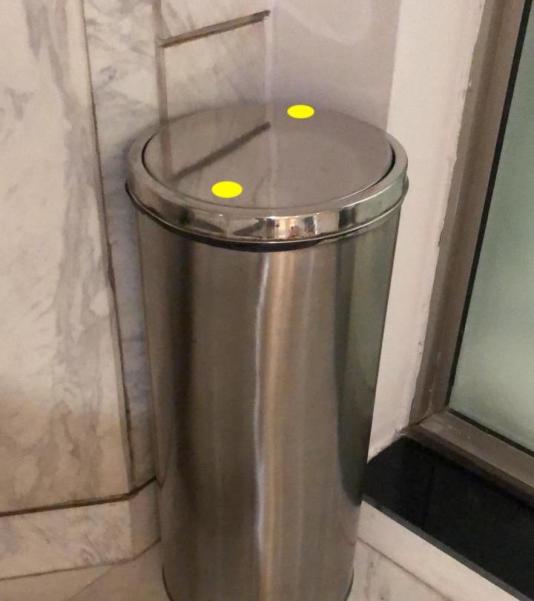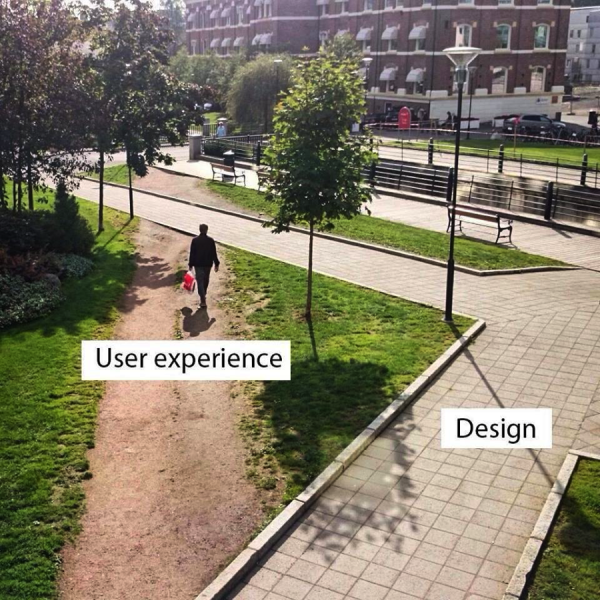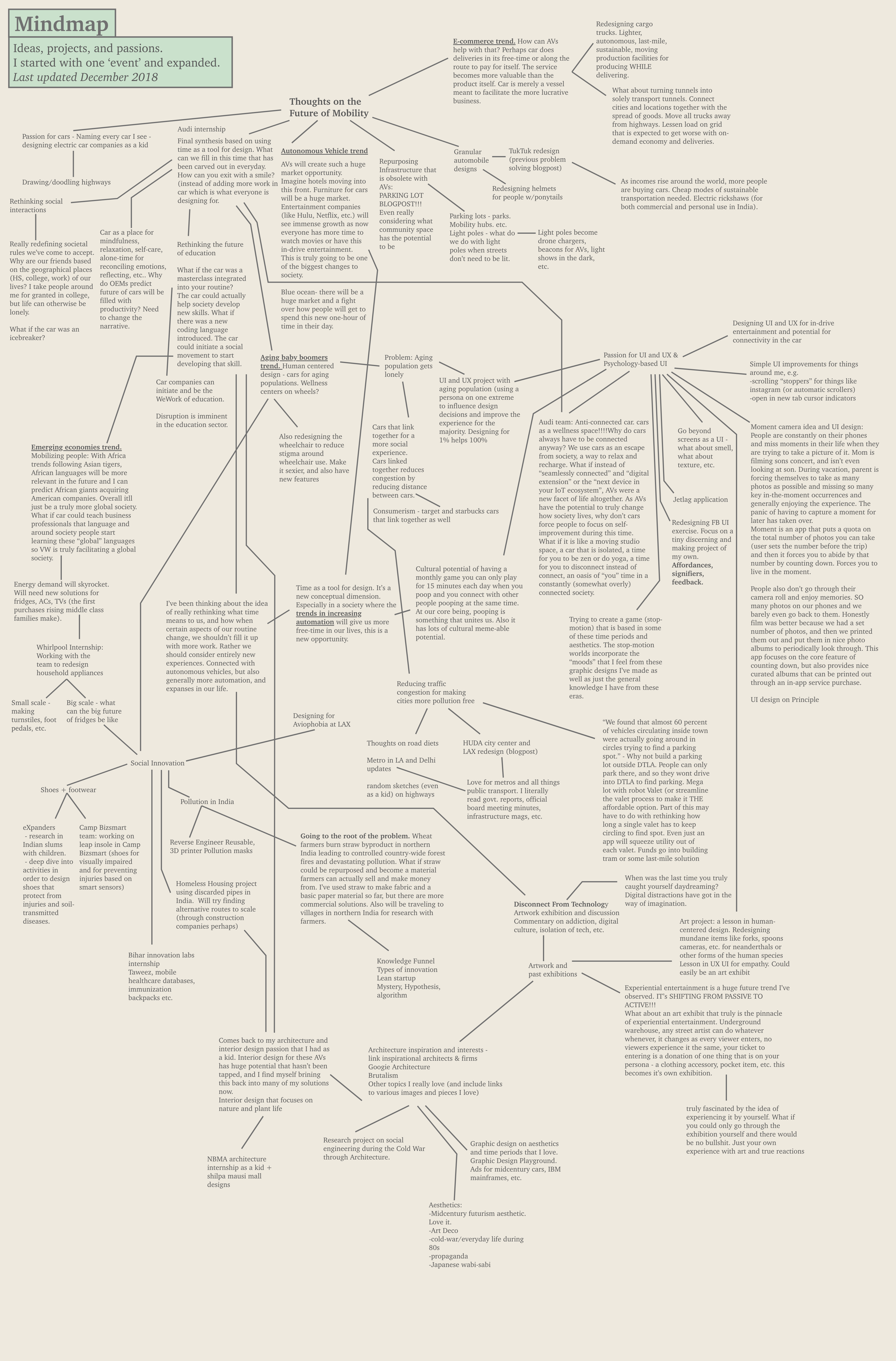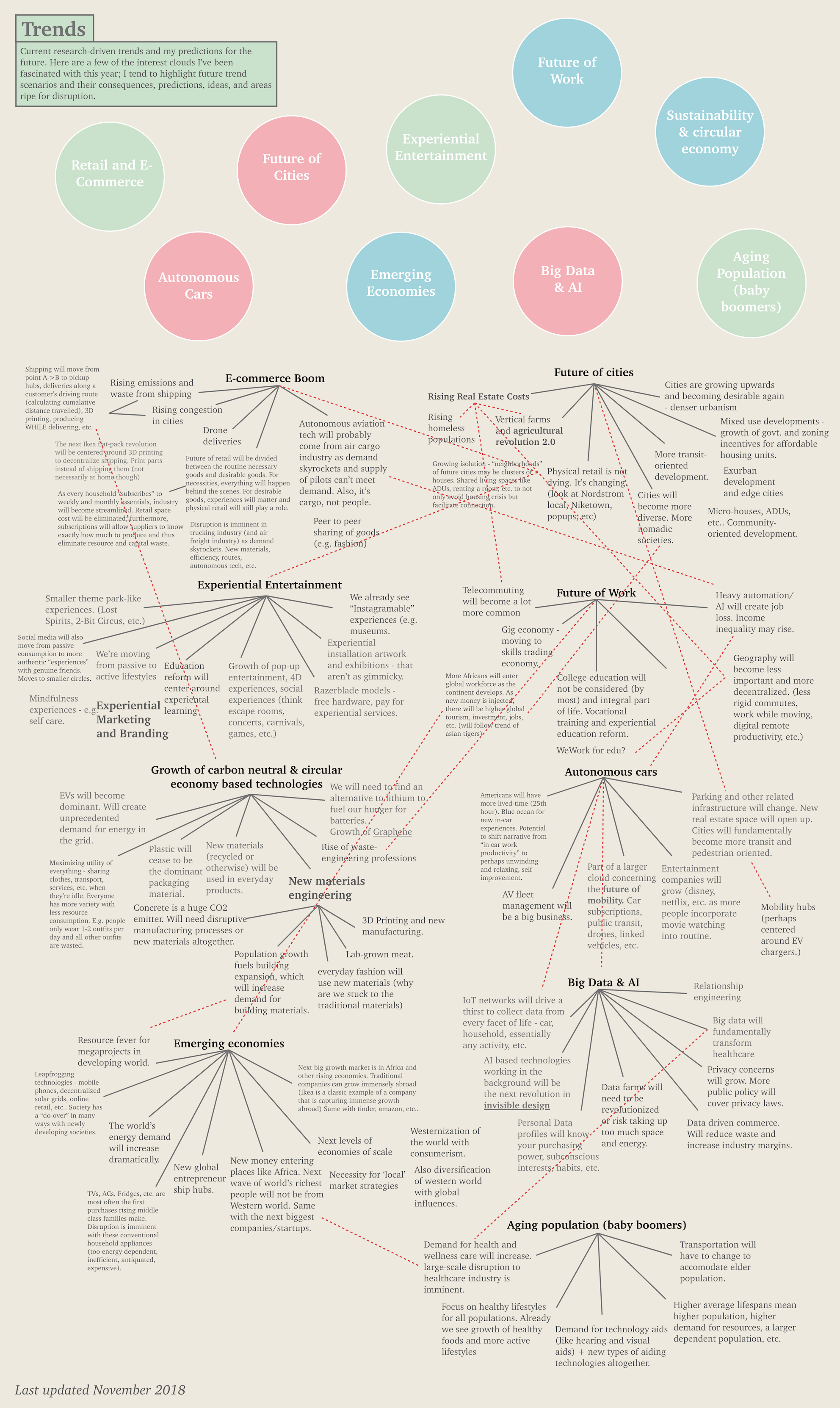Some design philosophies that guide me:
This journey is an accumulation of personal experiences and existing approaches from design firms, professors, books, etc.
Click titles to read more
Invisible Design
“Good designs fit our needs so well that [it] is invisible” – Don Norman
The best design often makes our life better without us even realizing. Appropriate affordances, signifiers, and feedback contribute to this philosophy.
A sticker on this trash can, for example, is an example of an affordance that leads to better user experience; no one has to even momentarily pause or struggle to realize which way the trash can swivels. Invisible design principles could have eliminated the need for these stickers.
Invisible design blends into routine instead of requiring new behaviors. This means incorporating “infrastructure” – what loosely defines all the things (usually routine based) that people interact with at any time. Doors, boarding passes, chairs, etc.. In this case, the antithesis of invisible design: products/services that force users to adjust their behaviors. A new device that needs to be charged has a higher likelihood of failure for example (it’s why I stopped using my Fitbit).
People and Inspiration
A lot of different things inspire me; people, places, experiences, observations, other artists, and other entrepreneurs. Mostly though, I find this inspiration comes from observation. I think various terms exist: user centered design, human centered design, etc. etc.. At the end of the day though, it is an intense dive into a subject that makes my mind whir the most.
I'm fascinated in particular with social fabrics and behavioral science. When it comes to city planning, urbanism and architecture, observing culture and human interactions is a topic I find myself passionately exploring.
I think the best example comes from an experience I had last year; a group of friends and I embarked on a process to understand how we could help older adults lead more fulfilling lives. An open ended question like this is the perfect design prompt. Gerontology is a space that none of us had any domain expertise in. With each day, however, we hustled to figure things out. The first week was filled with lots of dumb questions. I skipped a week of classes to camp outside the gerontology building and threw as many questions as I could to anyone leaving the building. Cold emails and phone calls were my best friend while I was waiting. The cookie trail of inspiration began here. Some conversations led forward and soon I found myself at a similar process weeks later when my team had legal and regulatory questions and I found myself outside the Gould school of law.
We also followed nurses on their routine and listened to many patients’ stories. Although we got barrels of insights, my biggest takeaway: always carry a lighter. Nurses opened up to me the most after I offered them a light during their smoke break.
Another weekend, I finagled my way into the Aging Into the Future conference at the LA convention center by posing as a volunteer. I found myself spending most of my time at the tech support booth where most older adults gravitated towards and understanding a lot more about the digital literacy rates and limitations amongst this population.
Although every week was a new challenge, we slowly narrowed our grasp of how we could approach this space. It felt like a scavenger hunt where we not only had to find an answer to the current problem, but we had to find the next question to ask and the next problem to approach. Here, it was the conversations and the people I engaged with that were most inspiring.
I find myself doing a lot of these deep dives, and even if I move onto something new later on, I always look back most fondly on the initial conversations and research. Furthermore, the knowledge I get from immersion in a subject as esoteric as gerontology and the future of aging could influence how I pursue a project on fabric art.
I'm fascinated in particular with social fabrics and behavioral science. When it comes to city planning, urbanism and architecture, observing culture and human interactions is a topic I find myself passionately exploring.
I think the best example comes from an experience I had last year; a group of friends and I embarked on a process to understand how we could help older adults lead more fulfilling lives. An open ended question like this is the perfect design prompt. Gerontology is a space that none of us had any domain expertise in. With each day, however, we hustled to figure things out. The first week was filled with lots of dumb questions. I skipped a week of classes to camp outside the gerontology building and threw as many questions as I could to anyone leaving the building. Cold emails and phone calls were my best friend while I was waiting. The cookie trail of inspiration began here. Some conversations led forward and soon I found myself at a similar process weeks later when my team had legal and regulatory questions and I found myself outside the Gould school of law.
We also followed nurses on their routine and listened to many patients’ stories. Although we got barrels of insights, my biggest takeaway: always carry a lighter. Nurses opened up to me the most after I offered them a light during their smoke break.
Another weekend, I finagled my way into the Aging Into the Future conference at the LA convention center by posing as a volunteer. I found myself spending most of my time at the tech support booth where most older adults gravitated towards and understanding a lot more about the digital literacy rates and limitations amongst this population.
Although every week was a new challenge, we slowly narrowed our grasp of how we could approach this space. It felt like a scavenger hunt where we not only had to find an answer to the current problem, but we had to find the next question to ask and the next problem to approach. Here, it was the conversations and the people I engaged with that were most inspiring.
I find myself doing a lot of these deep dives, and even if I move onto something new later on, I always look back most fondly on the initial conversations and research. Furthermore, the knowledge I get from immersion in a subject as esoteric as gerontology and the future of aging could influence how I pursue a project on fabric art.
Jugaad
Jugaad doesn't have any direct translation into English. So I'll try and break it down using the tenets I believe in.
Jugaad is an innovation philosophy that values maximizing the utility from any resource; frugal innovation. Simple ‘hacks’. Out of the box thinking for hyper-focused problems. Recycling. Upcycling. All of this is part of Jugaad.

Jugaad is a form of design where cost is often used as the major constraint. Essentially, it is integral to avoid over-engineering a product or service.
Jugaad is an innovation philosophy that values maximizing the utility from any resource; frugal innovation. Simple ‘hacks’. Out of the box thinking for hyper-focused problems. Recycling. Upcycling. All of this is part of Jugaad.

Jugaad is a form of design where cost is often used as the major constraint. Essentially, it is integral to avoid over-engineering a product or service.
Trace Problems to their Roots
Find the goals behind the goals and the root problems instead of the symptoms. Trace a design prompt back and ask “why?” Take for example a project where I redesigned a pollution mask using Jugaad innovation principles. Had I stopped here, this pollution mask – although effective – would have hindered bigger picture innovation and problem-solving. This is where tracing the problem to its root comes into play:
- Why are masks too expensive?
- Redesign a mask with replaceable filters
- Why do we need pollution masks?
- To protect ourselves from the effects of air pollution
- Why is there air pollution?
- Crop burning, vehicular pollution, factory pollution, waste burning, etc.
Inclusive and Universal Design
Design for the 100% by designing for the 1%. A better product/service can be attained by focusing on the outliers of any user segment. This is done through empathy. Putting oneself in the shoes of an extreme user-case is an invaluable design exercise. Try wearing monochromatic glasses and going through a red light. What does a red-light even mean? Or better yet: wear a blindfold and walk through a metro station.
Look at Veggie peelers or Sidewalk ramps for good examples of universal design.
There are hundreds of articles about this. I also think it’s one of the most important tenets of impactful design. I’ve noticed universal design plays a big role in environmental design, but it needs to be regarded with the same value in any case. In UI concepts, for example, I often test the product with elderly users.
Look at Veggie peelers or Sidewalk ramps for good examples of universal design.
There are hundreds of articles about this. I also think it’s one of the most important tenets of impactful design. I’ve noticed universal design plays a big role in environmental design, but it needs to be regarded with the same value in any case. In UI concepts, for example, I often test the product with elderly users.
The Lean Startup & “Going to the Gemba”
The Lean Startup emphasizes user discovery, which more often than not leads to problem discovery. It’s a form of going to the Gemba – immersing oneself in the market, shadowing customers, engaging with the problem, stepping in an employee’s shoes. It focuses on empathy. It focuses on truly understanding by going and doing.
Fail fast. Fail small. Repeat. I often get caught up in an idea, focus on building it out, and only then ‘launch’ it. When failure happens at this stage, time and energy are wasted. Instead, challenging an idea at its initial stage helps me realize when to pivot without too much at stake.

Desire Paths, for example, are what happens without the Lean Startup. Instead of designing a solution for the user, solutions should be designed around the user.
One of the key takeaways I’ve learned: don’t let perfection get in the way of shipping. Instead, get a good-enough product out there and refine it through user-centric iterations. “Real artists ship” – Steve Jobs
Fail fast. Fail small. Repeat. I often get caught up in an idea, focus on building it out, and only then ‘launch’ it. When failure happens at this stage, time and energy are wasted. Instead, challenging an idea at its initial stage helps me realize when to pivot without too much at stake.

Desire Paths, for example, are what happens without the Lean Startup. Instead of designing a solution for the user, solutions should be designed around the user.
One of the key takeaways I’ve learned: don’t let perfection get in the way of shipping. Instead, get a good-enough product out there and refine it through user-centric iterations. “Real artists ship” – Steve Jobs
Trend-Based
“The fundamental interconnectedness of all things” – Steve Barth
Examine how everything is interconnected. Trend-based analysis helps in finding opportunities for innovation and future Blue Oceans through predictions and understanding of future markets. As an exercise, try taking a random trend and imagining its impact on the future of another product. For example, how can retail companies take advantage of the trend toward autonomous vehicles?When I do trend analysis, a couple of things inform my thoughts: I flip most of the articles I read into my Flipboard magazines. The categories and articles have evolved over the years along with my interests and curiosity, and as thousands of articles accumulate, my trend-based intuition, which I believe to be one of my strengths, grows. For trend mapping, it helps to predict the mild, the wild, and the in-between. Sci-fi helps me with the wild. As a kid, I was obsessed with reading and writing sci-fi. It’s still a huge passion of mine, and I channel this when imagining wild-future case scenarios. It’s an exercise that, when used in moderation, helps broaden the mind to the bigger picture. Considering the wacky future ahead of us is also fun on its own.
Some of the things I thought about during 2018 are centered around a few obsessions, which you can see in my trend mind maps.

Sci-Fi
Giving myself an acceptable framework to think crazy. Drawing inspiration from historical sci-fi.
Get rid of feasibility and viability from the equation. I let my mind wander, create worlds, and just enjoy boundless - almost childlike - creativity. Interestingly, it's a really inspirational exercise because a lot of various pieces of stories or worlds or future products have merit even in regular societal constructs.
World building at its purest helps me question a lot of the assumptions in our lives. We're bound by what has been done, what seems like it can be done, and what might be accepted. Sci-fi, however, can open the door to entirely new ways of framing societal behaviors. Sidenote: scifi alludes to a cyclical process in society where history repeats itself in the future. E.g. gig economy is a repetition of pilgrim culture. Or Airbnb pulled inspiration from travelers seeking lodge at strangers houses along their path.
Get rid of feasibility and viability from the equation. I let my mind wander, create worlds, and just enjoy boundless - almost childlike - creativity. Interestingly, it's a really inspirational exercise because a lot of various pieces of stories or worlds or future products have merit even in regular societal constructs.
World building at its purest helps me question a lot of the assumptions in our lives. We're bound by what has been done, what seems like it can be done, and what might be accepted. Sci-fi, however, can open the door to entirely new ways of framing societal behaviors. Sidenote: scifi alludes to a cyclical process in society where history repeats itself in the future. E.g. gig economy is a repetition of pilgrim culture. Or Airbnb pulled inspiration from travelers seeking lodge at strangers houses along their path.
My Visual Process
My visual journey is a form of organized chaos. It starts with a single Google search that branches out into hundreds of Chrome browser tabs. A spark of curiosity is all it takes for my computer’s fan to run on overdrive.
I annotate articles, jot down and sketch ideas in my notebook, write stream-of-consciousness thoughts on Google Drive and bullet points on Google Keep and Notion. I keep an ever-evolving mind map on Adobe XD and an archive of meaningful articles I read on Flipboard. Eventually, this blur in my mind coalesces using a medium that I feel will communicate my ideas the best. Often that means just writing out words. The goal here is to prevent the software from inhibiting the flow of my thoughts; hence only opening them after a brainstorm has been ignited.
This is a design process that consists of unconventional mood boards and constant outlets for curiosity. In the end, I’ve found it helps me to reflect on the journey. Then I start all over again.
I annotate articles, jot down and sketch ideas in my notebook, write stream-of-consciousness thoughts on Google Drive and bullet points on Google Keep and Notion. I keep an ever-evolving mind map on Adobe XD and an archive of meaningful articles I read on Flipboard. Eventually, this blur in my mind coalesces using a medium that I feel will communicate my ideas the best. Often that means just writing out words. The goal here is to prevent the software from inhibiting the flow of my thoughts; hence only opening them after a brainstorm has been ignited.
This is a design process that consists of unconventional mood boards and constant outlets for curiosity. In the end, I’ve found it helps me to reflect on the journey. Then I start all over again.

